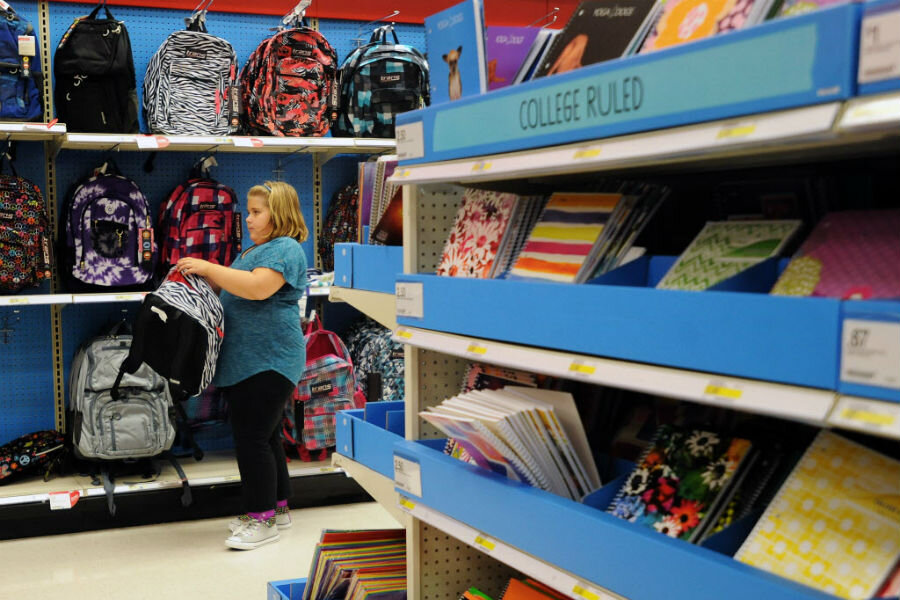How to find the best backpack for your child
Loading...
Back-to-school season will be here before you know it. On top of this year's school supplies, your child will need a bag to carry everything in. Finding the right backpack for school should be more than an afterthought; a good bag helps students keep everything they need organized and within easy reach. Whether they're just starting first grade or they're high school seniors, design is important.
Whatever your child's age, we'll walk you through every consideration to find the best back-to-school backpack.
Backpacks vs. Other Bags
With two straps to help distribute weight evenly across the body, backpacks reduce the strain that comes from carrying a heavy load. The more your child is carrying, the more important distributing that weight is — making it a better idea to buy a backpack than a shoulder or messenger bag.
Some kids may want a different kind of bag for style purposes. However, if they're going to be carrying a lot of weight, a backpack will serve them better.
Size
Bags aren't one-size-fits-all; shop around until you find the bag that's just the right size for your child. A bag that's too big won't distribute weight properly, and you're back to the problem of strained muscles. When properly worn and adjusted, the right pack should go from the base of the neck to the top of the hips. If a bag comes in sizes, always look for the size appropriate to your child's age range. While the neck-to-hip measurement won't work for things other than backpacks, you still want to consider the size of any bag you buy; the bag should not dwarf your child.
While online shopping is all the rage, it's still good to shop for bags in stores, so you can check their fit and see how they work. Does the bag have the right selection of pockets to keep all of your child's things organized? Are the straps sturdily attached to the rest of the bag? These things can be hard to tell online.
Features
Pockets and organization: Consider what your child needs to carry, and confirm that the bag you choose has enough space to hold it — and keep things organized and easy to find.
Materials: Even though you're likely to replace bags for younger kids annually, you still want a bag that is sturdy enough to last the school year. Take a careful look at each bag; choose something with sturdy stitching, with straps and pockets that are firmly attached to the body of the bag. Nylon is a sturdy, light fabric that isn't too expensive — your best bet for a good bag at a reasonable price.
Bag weight: You don't want the bag itself to be too heavy, as it just adds to the weight your child has to carry.
Straps and padding: No matter what kind of bag you buy, it should have wide, padded straps to distribute weight and keep your kid comfortable. If your child is going to be carrying more weight, back padding and a waist belt are also important.
Reflective strips: Reflective straps or patches help make your child visible when walking or bicycling. (However, it's simple enough to add reflective patches to a bag that doesn't have them.)
Warranty: A good warranty is a sign of quality, and as your children get older, you'll want one to ensure their bag lasts — or can be replaced if it doesn't.
Durability
A high quality backpack can last for years. For a younger child, though, plan on replacing the bag annually to maintain a good fit as your child grows. This means that while you want to find bags that are sufficiently high quality to last the school year, you don't want to make a big investment in them. As kids get into their late teens — past those pesky growth spurts — you can consider investing a bit more in a bag, with the expectation that it could last into college.
The only snag is that as styles change, your teens may not be happy with last year's bag. Consider whether they're likely to hold on to the same bag for years before you spend too much on one.
Buying Used/Hand-Me-Downs
If you have a hand-me-down backpack (or find a used pack) that's the right size and still in good shape, there's nothing wrong with giving it a second life. But just like with a new backpack, have your child try it on to make sure it's a good fit.
Price
You can pay as little as $20 and as much as $100 on a decent bag. Expect to spend more on bags for a high schooler than a first-grader. These bags will be sturdier, and are likely to have extra pockets and other features to accommodate everything an older student needs to carry.
You should be able to find a decent school bag in the $20 range for a young student and in the $50 range for a high school student.
Brands
The younger your child, the less important brand is. Young children don't need any special features, and long-term durability is less of a concern because you'll have to replace the backpack. However, these two solid brands work for a child of any age: JanSport and L.L.Bean. Both brands offer sturdy packs with a lifetime warranty — so they're sure to last. Lots of options are available from each, including basic backpacks, wheeled backpacks, and laptop backpacks.
Finding Bargains
If you're looking to save, expect to see backpack discounts as we get closer to back-to-school season. In the past, we've seen backpacks and other bags significantly marked down from late summer through Labor Day — so if you're balking over prices today, keep your eyes open for sales.
This article first appeared at Dealnews.com.







